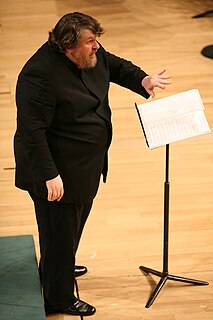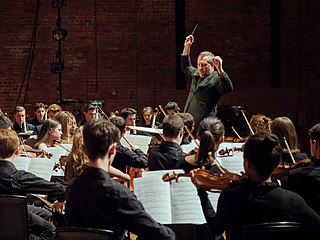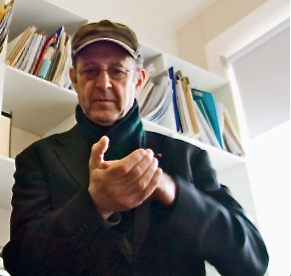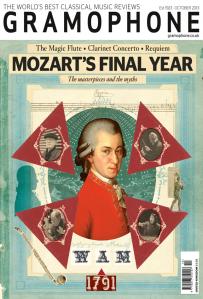
The Aldeburgh Festival of Music and the Arts is an English arts festival devoted mainly to classical music. It takes place each June in the Aldeburgh area of Suffolk, centred on Snape Maltings Concert Hall.

Sir Simon Denis Rattle is a British conductor.

Stuart Oliver Knussen was a British composer and conductor.

Thomas Adès is a British composer, pianist and conductor.

Felix Mendelssohn's Violin Concerto in E minor, Op. 64, is his last large orchestral work. It forms an important part of the violin repertoire and is one of the most popular and most frequently performed violin concertos in history. A typical performance lasts just under half an hour.
Julian Anderson is a British composer and teacher of composition.
Birmingham Contemporary Music Group (BCMG) is a British chamber ensemble based in Birmingham, England specialising in the performance of new and contemporary music. BCMG performs regularly at the CBSO Centre and Symphony Hall in Birmingham, tours nationally and worldwide and has appeared several times at the Proms in London.

Susanna Ulla Marjukka Mälkki is a Finnish conductor and cellist. She is the daughter of Pirkko Liisa Vainio and the marine scientist Pentti Mälkki.
Tevot is a one-movement symphony for orchestra by the British composer Thomas Adès. The work was commissioned by the Berlin Philharmonic and Carnegie Hall. The world premiere was given by the Berlin Philharmonic under the direction of Simon Rattle at the Berliner Philharmonie on February 21, 2007. The United States premiere was given by the same ensemble at Carnegie Hall on November 14, 2007.
Charlotte Bray is a British composer.
Alexandra Wood is a violinist from Cookham, England. She began playing at 3 years old, gaining 140 marks for her grade VIII Associated Board of the Royal Schools of Music examination at the age of 10. She gave her first concerto performance at 13, joined the National Youth Orchestra of Great Britain in the same year which she went on to lead in her mid teens.

Radio Rewrite is a 2012 work for instrumental ensemble by American composer Steve Reich, inspired by two songs by British rock band Radiohead: "Jigsaw Falling into Place" and "Everything in Its Right Place". The piece represents the first time that Reich has reworked material from western pop/rock music. It has five movements, alternating fast and slow, and is scored for clarinet, flute, two violins, viola, cello, two vibraphones, two pianos and electric bass. The work premiered in London, UK in 2013, performed by the London Sinfonietta, to a generally positive reception. Much attention focused on the Radiohead material, with some reviewers praising how completely it is integrated, while others question whether Radiohead's style is suited to Reich's work. Alarm Will Sound made the first recording of the piece for an album of the same name released on Nonesuch Records in 2014.

Sinfini Music was a classical music website containing written features and reviews, news, animations, cartoons, quizzes and filmed sessions. The site was owned by Universal Music Group but claimed to be editorially independent, covering music and releases from all record labels, artists and venues.

Mirga Gražinytė-Tyla is a Lithuanian conductor. She is currently music director of the City of Birmingham Symphony Orchestra (CBSO) in England.
Sunset Strip is an orchestral composition in three movements by the American composer Michael Daugherty. The piece was composed in 1999 and premiered January 7, 2000 at the Ordway Center for the Performing Arts in Saint Paul, Minnesota, with conductor Hugh Wolff leading the Saint Paul Chamber Orchestra.
The Violin Concerto is a concerto for violin and orchestra in two movements by the American composer Christopher Rouse. The work was commissioned for violinist Cho-Liang Lin by the Aspen Music Festival and School and funded in part by a grant from the National Endowment for the Arts. It was completed August 18, 1991 and is dedicated to Cho-Liang Lin.
At the Speed of Stillness is an orchestral composition in one movement by the British composer Charlotte Bray. The work was commissioned by The Proms for the conductor Sir Mark Elder and the Aldeburgh World Orchestra. It was first performed July 29, 2012 at the Proms by the Aldeburgh World Orchestra under Sir Elder. The piece is dedicated to the British composer Mark-Anthony Turnage.
Fire Burning in Snow is a composition for mezzo-soprano solo and chamber ensemble by the British composer Charlotte Bray. The work was commissioned by the Birmingham Contemporary Music Group with the support of individual donors in memory of the arts administrator Jack Phipps. It was first performed on June 18, 2013 at the Aldeburgh Festival by mezzo-soprano Lucy Schaufer and the Birmingham Contemporary Music Group. The piece is set to three poems by Nicki Jackowska. Bray dedicated the composition to Jackowska and to the memory of the composer Jonathan Harvey.
Black Rainbow is an orchestral composition in two movements by the British composer Charlotte Bray. The work was commissioned by the City of Birmingham Symphony Orchestra and was first performed in Birmingham on February 23, 2014 by the CBSO Youth Orchestra under conductor Jac van Steen.
The Sun Was Chasing Venus is a composition for string quintet by the British composer Charlotte Bray. The work was commissioned by the violinist Daniel Hope and the Savannah Music Festival. It was first performed at the Savannah Music Festival on April 3, 2014 by the Dover Quartet and violist Daniel Lee.



















